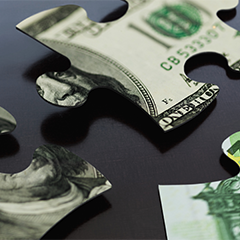How Industry Fits Into the Valuation Puzzle
November 13, 2015 | Business Plans, Uncategorized, Valuations
 IRS Revenue Ruling 59-60 is an essential building block of modern appraisal practice. It identifies “the condition and outlook of the specific industry” as one of the factors to consider when valuing a private business. But how do investors measure industry risk and how does it fit in the valuation paradigm?
IRS Revenue Ruling 59-60 is an essential building block of modern appraisal practice. It identifies “the condition and outlook of the specific industry” as one of the factors to consider when valuing a private business. But how do investors measure industry risk and how does it fit in the valuation paradigm?
Risk and Return
Value is a function of risk and return, and some rates of return can be easily and objectivity measured, but riskier investments require higher returns, which lowers their values. For example, the return on the overall market may be measured by returns on a diversified portfolio of public stocks that are traded actively on the New York Stock Exchange, NASDAQ and the American Stock Exchange.
However, private Maine companies often participate in one industry, which may be more (or less) risky than a diversified portfolio of stocks. In a discounted cash flow analysis, the company’s discount rate must be adjusted (up or down) to reflect industry risk.
For example, assume that a small publicly held company in the general public market has an annual rate of return of 15 percent (as measured by the market for similar sized public companies). If your business operates in an industry that’s less risky than the overall market, it may warrant a discount rate below 15 percent. Conversely, if your business operates in a volatile, high risk industry, investors may require a higher rate of return than the overall market.
Introducing Beta
Premiums are determined by measuring the betas of representative public companies within each industry classification code. To measure industry risk, valuators typically turn to outside research firms that compute industry risk premiums (commonly known as “betas”) for public stock and credit analysts. Duff & Phelps publishes over 200 industry risk premiums in its annual Valuation Handbook.
Industry betas based on public stocks don’t factor size or geographic location into the equation. Small industry participants may face different risk than larger players, especially conglomerates that participate in multiple industries. Small companies also tend to have fewer resources to weather temporary downturns in the economy.
A beta compares the industry’s historic rate of return to the historic rate of return for the overall market. A beta between zero and one means that the industry is less risky than the market. A beta of one means that the industry generally moves in tandem with the market. A beta greater than one means that the industry tends to be riskier than the market overall. Betas below zero are rare and reserved for companies that move in an opposite direction than the market. In other words, the industry performs well in tough economic times and poorly in good times.
To illustrate, consider eating and drinking establishments (standard industrial classification code 58). The three largest companies in that industry are McDonalds, Starbucks and Yums Brands. None of those companies would likely be impacted by local economic conditions or the vagaries of running a small local mom-and-pop restaurant.
So how do valuators determine the risk of operating a small private company? The industry premium (or discount) to apply to a required rate of return is a matter of professional judgment on the part of your appraiser. He or she might start with the industry beta, review industry trade publications and then make adjustments for size and company-specific risks.
Which Industries Are the Riskiest?
Another possible source is the industry-risk scores prepared by IBISWorld, a well-known industry research firm. From 2014 through 2015, the 10 riskiest U.S. industries (with risk scores provided in parentheses) are expected to be:
- Appliance Repair (7.06)
- Recordable Media Manufacturing (6.98)
- Cigarette and Tobacco Products Wholesaling (6.95)
- Vacuum, Fan and Small House Appliance Manufacturing (6.92)
- Cigarette and Tobacco Manufacturing (6.92)
- Women’s and Girl’s Apparel Manufacturing (6.91)
- DVD , Game and Video Rental (6.86)
- Computer Manufacturing (6.86)
- Corn Farming (6.67)
- Men’s and Boy’s Apparel Manufacturing (6.66)
IBISWorld bases its risk scores on a scale of one to nine, where one represents the lowest risk and nine represents the highest. To calculate overall risk scores, IBISWorld assesses the risks pertaining to industry structure (structural risk), expected future performance (growth risk) and economic forces (sensitivity risk).
IBISWorld also publishes industry write-ups with such information as growth estimates, major companies in the industry and the relative market shares of specific companies.
Think Beyond the Valuation
The research done to produce a valuation report offers tremendous value beyond your company’s valuation because they offer significant detail about the industry risks and trends. These reports can help owners and managers seize opportunities, anticipate threats, and employ best practices to help build your company’s value. Industry risk is an important consideration when valuing a private Maine-based business, and valuators, like Filler & Associates, go to great lengths to support their risk assessments and conduct in-depth market research.
